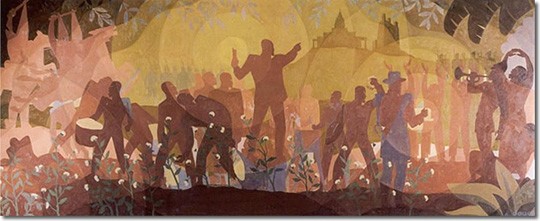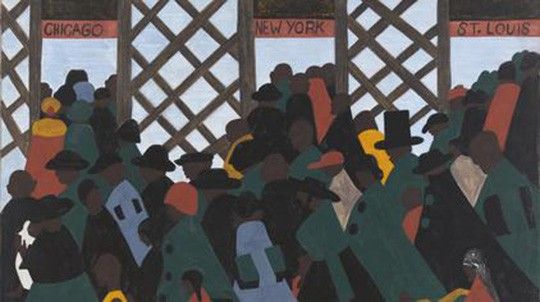3.11 Harlem Renaissance
LISTEN
Harlem Renaissance (https://boisestate.pressbooks.pub/arthistory/chapter/modernism-america/)
Key Points:
- Racial consciousness was the prevailing theme of the Harlem Renaissance, an African- American cultural movement in the 1920s named for the historically black Harlem neighborhood of New York City.
- The Renaissance was built upon the “New Negro Movement”, which was founded in 1917 by Hubert Harrison and Matthew Kotleski as a reaction to race and class issues, including calls for political equality and the end of segregation.
- In several essays included in the 1925 anthology, The New Negro, editor Alain Locke contrasted the “Old Negro” with the “New Negro” by stressing African-American assertiveness and self-confidence during the years following World War I and the Great Migration.
- Seeking to counteract the rise in racism during the postwar years, black artists, writers and musicians developed unique styles that challenged pervading stereotypes of African- American culture as the Harlem Renaissance developed.
The Harlem Renaissance was an arts and literary movement in the 1920s that brought African- American culture to mainstream America. During the early portion of the 20th Century, Harlem became home to a growing middle class primarily consisting of African Americans. In 1910, a large block along 135th Street and Fifth Avenue was purchased by various African-American realtors and a church group. More people arrived during World War I. Due to the war, the migration of laborers from Europe virtually ceased, while the war effort resulted in a massive demand for unskilled industrial labor. The Great Migration brought hundreds of thousands of African-Americans from the South to cities like Chicago, Philadelphia, Cleveland, and New York. Among them were a great number of artists whose influence would come to bear, especially in Jazz music.
Artists of the Harlem Renaissance distinguished themselves in theater, literature, music, and the visual arts. Langston Hughes, Zora Neale Hurston, Aaron Douglas, Jacob Lawrence, Augusta Savage, Romare Bearden, and many others created work in an extraordinary moment of artistic expression and invention that began in about 1920.
Aaron Douglas painted murals for public buildings and in 1940 founded the Art Department at Fisk University where he taught for almost thirty years. During the Depression, he painted a WPA (Works Progress Administration) mural for the 135th St. branch of the New York Public Library in Harlem. Aspects of Negro Life was a four-panel series that chronicled the social and cultural history of African Americans from slavery to modern life.



Augusta Savage was a sculptor, activist, and teacher, and was the first black artist to be elected to the National Association of Women Painters and Sculptors.3 Much of her work was in clay or plaster; bronze was too expensive for her and she struggled with finances for much of her life.
Her work was realistic and expressive, unlike the more abstract work of many artists of the time.
Please Read
Dudley, Tara. “Seeking the Ideal African-American Interior: The Walker Residences and Salon in New York.” Studies in the Decorative Arts, vol. 14, no. 1, 2006, pp. 80–112, http://www.jstor.org/stable/40663289
Gregorio, Maria. “Harlem and the Historical Influence of Black Artists.” One TwentyFifth, https://onetwentyfifth.commons.gc.cuny.edu/non-fiction/harlem-identity-the-historical-influence-of-black-artists/.
Please Watch
Explore:
Jacob Lawrence’s Migration Series from the 1940s onwards – https://lawrencemigration.phillipscollection.org/
and one or two of the articles from this OER https://uw.pressbooks.pub/arth400jacoblawrence
For additional references to racism experienced by African American peoples during the late nineteenth and early twentieth century: Visit https://courses.lumenlearning.com/ushistory2ay/chapter/jim-crow-and-african-american-life-2/

